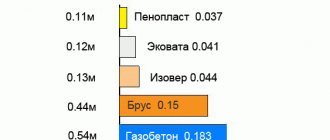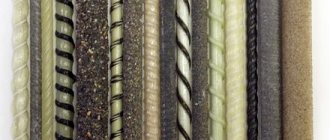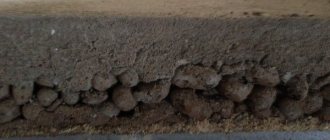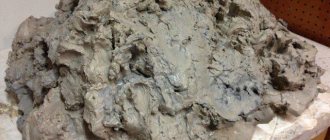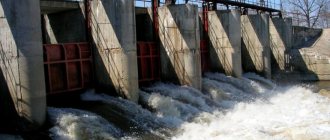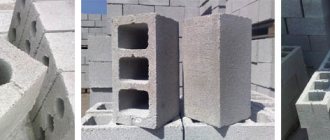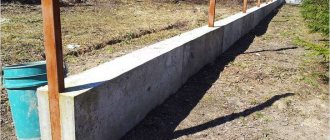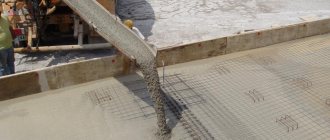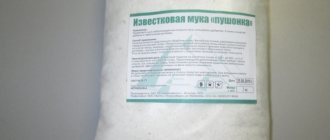Parameters, characteristics, features
It has distinctive features, including technical indicators, methods of use and setting times.
Initial components of the composition
The composition of Portland slag cement includes:
- granulated blast furnace slag, containing in cement, depending on the specified parameters and characteristics, from 20 to 80%, with an average optimal value of up to 50%;
- clinker minerals with an acceptable magnesium content of up to 6%;
- natural gypsum with the possible presence of fluorine, boron, phosphorus: the total mass of the mineral is not more than 5%.
All components of Portland slag cement are dried until a maximum moisture content of 1% is reached, then crushed into a fine powder.
Composition and technical characteristics
Portland slag cement is a hydraulic substance with astringent properties intended for the preparation of construction mixtures. It consists of the following components:
- Granular or non-granular blast furnace slag. Their content ranges from 25 to 75%, depending on the required properties of the final product. The average value is 35-45%.
- Portland cement clinker. Taking into account the slag component, the content of this ingredient ranges from 10 to 70%. The presence of magnesium is allowed in it, but not more than 6%.
- Natural (natural) gypsum in quantities up to 5-6%. Allowed content of phosphorus, fluorine, boron.
A common type of material is lime-slag cement. Instead of clinker, hydrated or quicklime is added to it (up to 30%).
The manufacturing technology of Portland slag cement includes 2 main operations. At the first stage, the slag is dried to a residual moisture content of no more than 1%. The next step is to carefully grind and mix the ingredients in a special mill. The result is a homogeneous, fine powder.
Basic properties
- The density of the material ranges from 2.7-3.1 g/cub.cm, and the bulk, volumetric mass is 880-1250 kg/cub.m.
- Strength characteristics. In terms of compressive strength, it comes in grades from M200 to M500. Has low volumetric deformation.
- Heat resistance reaches 850 degrees.
- Water resistance and resistance to aggressive environments, such as sulfates, are noted.
The material has a slow setting. However, the longer curing occurs, the stronger the structure becomes.
At the initial stage, the strength of the material increases slowly, and sufficient strength parameters are achieved only after 7-10 months. In this case, the best characteristics are achieved when hardening in a humid environment at elevated temperatures. To accelerate complete setting and strength gain, clinker with aluminate and silicate, as well as alumina slag, is used.
Main advantage and distinctive features
The main advantage of slag cement is its low cost. When comparing the same brands of Portland cement and Portland slag cement in terms of strength, there are no significant differences, and with large volumes of cement purchases, the difference in price can be a determining factor in the choice of cement. But the ShPC has distinctive features, although not clearly expressed:
the increase in initial and critical strength of mixtures based on Portland slag cement is much slower, but the quality increases sharply after about 20 days of hardening;
in comparison with Portland cement, in mixtures with ShPC, less heating occurs during hardening, which can be called a slight disadvantage when carrying out construction work at low positive temperatures;
Slag cement has a lower specific gravity and density in finished concrete products and structures.
Definition and description of slag
The American Society for Testing and Materials (ASTM C125) defines blast furnace slag as “a non-metallic product, consisting primarily of calcium silicates and aluminates, produced together with pig iron in a blast furnace as a melt.”
When producing pig iron, the blast furnace is charged with iron ore, flux stone (limestone and/or dolomite) and coke. The products obtained at the outlet of the furnace are molten cast iron and slag. The slag consists mainly of quartz and aluminum oxides (from iron ore) and calcium and magnesium oxides (from flux stone). The slag leaves the furnace in a molten state, and the melt temperature can exceed 1480? C (2700? F). There are four main methods for processing molten slag: air cooling, cold water rapid cooling (slag swelling), crushing and grinding. Each of these processing methods produces a unique slag material with distinctive properties.
Chemical properties
The main components of blast furnace slag are quartz, oxides of aluminum, calcium and magnesium, which account for 95% of the total composition of the slag. The remaining 15% is manganese, iron and sulfur compounds and trace amounts of other elements. However, it should be noted that the main oxides included in the slag are not found in free form. In air-cooled blast furnace slag, the oxides combine to form various silicates and aluminosilicate minerals such as melilite, merwinite, wollastonite, etc., which also exist as natural rocks. In crushed and ground slag, these elements are present in the form of glass. The chemical composition of slag varies within very narrow limits, since all raw materials loaded into a blast furnace are very carefully selected and mixed.
| Typical chemical composition of blast furnace slag, % | |
| quartz(SiO2) | 32-42 |
| aluminum oxide(A12O3) | 7-16 |
| calcium oxide (CaO) | 32-45 |
| magnesium oxide (MgO) | 5-15 |
| sulfur (S)* | 1-2 |
| iron oxide (Fe203) | 1-1,5 |
| manganese oxide (MnO) | 0,2-1,0 |
*mainly in the form of calcium sulfide
Physical properties
Physical characteristics of the slag, such as weight, particle size, structural properties, etc. vary depending on the method of processing the molten slag. Accordingly, the end use of the treated slag also differs depending on the processing method.
Recently, in Russia and other countries, much attention has been paid to the problem of using secondary resources. One of the most promising areas for recycling industrial waste is its use in the production of building materials.
Metallurgy occupies one of the leading places among other industries. At the main technological stages of the production of ferrous and non-ferrous metals, by-products are formed - waste, the chemical and mineralogical composition and physical and mechanical properties of which allow them to be considered a valuable raw material for the production of building materials. The bulk of waste from metallurgical processes is formed in the form of slag.
Slags are products of high-temperature interaction between the components of source materials - fuel, ore, flux and gaseous medium. It is perhaps difficult to find another raw material that would have so many valuable qualities and at the same time make its way to widespread use in the construction industry for so long, like slag. In many areas of the country, multi-storey buildings and industrial buildings were built from slag, bridges and dams were erected, and highways were laid. From being a burdensome waste product, it is becoming a recognized raw material for the construction industry.
The earliest attempt to use blast furnace slag dates back to 1589, when cannonballs were cast from it in Germany. Slag began to be used in construction only in the 18th century. In Nizhny Tagil, slabs for steps and paving stones for roads began to be cast from slag melts. In Sweden, cast slag stones were used instead of bricks to lay the tops of blast furnace shafts. In Russia and other countries, dump slag was used as crushed stone in the construction of roads. In subsequent years, the valuable properties of slag even more attracted the attention of scientists and practitioners around the world to the problem of using slag in construction.
To resolve issues of organizing slag processing, using it, coordinating scientific research and experimental work, the All-Union Slag Processing Office was created in Moscow in 1933. In many countries, special institutes and organizations have been created that deal with the use of slag in construction, sometimes on the basis of metallurgical plants: in the USA - the National Slag Association, in France - the Technical Association for the Study and Use of Blast Furnace Slag, in Canada - the National Slag Association, in England – British Slag Association. The organization of slag processing in different countries is not the same, which is explained by the specific conditions of each country. In England and Germany, slag products are obtained directly from metallurgical plants; in other countries, slag in a liquid state or partially processed is transferred to companies and special firms for the production of building materials. It is necessary to note the very effective actions of the US National Slag Association, whose merits include the creation of the slag processing industry. Slag is recognized as a mineral raw material. Slag processing is mainly carried out by firms independent of metallurgists, and only in a few cases do metallurgical companies process slag for their own needs and sell it [3]. In the USA, England, Germany, France, air-cooled metallurgical slags are mainly processed into crushed stone, used as ballast in the construction of railways, and also used as filler in the construction of airfield pavements and highways. Asphalt concrete pavements using slag aggregate are characterized by high strength, abrasion resistance, a high coefficient of adhesion, and the absence of shear deformations. All slag processing products are economically profitable. For example, crushed slag stone is 1.5-2 times cheaper than natural stone and requires 4.5 times less specific capital investments. Slag pumice is 3 times cheaper than expanded clay and requires 1.5 times less specific capital investments.
The main type of industrial product made from metallurgical slag is Portland slag cement. Granulated slag was first used as an additive in the production of cement in Germany in 1892.
Portland slag cement is a hydraulic binder that hardens in water and air, obtained by jointly finely grinding Portland cement clinker and granulated slag. The slag content in Portland slag cement according to GOST 10178-85 should be no less than 21 and no more than 60% of the cement mass [5]. According to the American standard, the slag content should be from 25 to 65%, according to the English standard, no more than 65%. In Germany, two types of slag Portland cement are standardized: iron Portland cement containing no more than 35% slag, and blast furnace cement with a slag content of 31 to 85%. In France, 4 types of slag Portland cement are produced: iron Portland cement with 20–30% slag, mixed metallurgical cement with 50% slag, blast furnace cement with 70% slag and slag-clinker cement containing at least 80% slag. Each of these types of cement is divided into two grades based on strength. In Germany, each type of Portland slag cement has three strength grades, but in England and the USA - only one grade, like ordinary Portland cement.
Portland slag cements are now widely used in many countries for general construction work, for hydraulic structures and for precast concrete products (for example, concrete pipes). They are not inferior in strength to Portland cement, but require more careful maintenance at high and low temperatures.
Historically, granulated blast furnace slag in Russia and some European countries has been used primarily for the production of cementitious materials, especially for the production of Portland slag cement. In the USA and Japan they are used mainly for the production of aggregate. The latter direction makes it possible to involve a significantly larger amount of slag in the construction complex than in the production of binders from it. The production of slag crushed stone is especially effective when using the technology of blast furnace slag processing. In this case, the thermal energy that was accumulated by the molten slag during the production of cast iron is used. This technology makes it possible to achieve significant savings in fuel and energy resources.
In recent years, there has been an increase in slag dumps around Russian metallurgical plants. One of the reasons for the decrease in the use of blast furnace granulated slag by the cement industry is the fall in demand for Portland slag cement. In this regard, expanding the scale of production of slag aggregate, including slag pumice, which is a substitute for expanded clay, as well as cast slag crushed stone for heavy concrete, is of great importance.
It must be emphasized that concrete with granulated blast furnace slag aggregate has a number of advantages over traditional concrete. As it was established in the works, blast furnace slag in the composition of Portland cement concrete performs the function of an active filler, i.e. its surface layer reacts with calcium hydroxide released during the hydrolysis of alite. In this case, an additional amount of calcium hydrosilicates is formed, which creates an extremely strong bond between the aggregate and the cement matrix, and the capillary channels that form between it and the surface of the aggregate as a result of shrinkage of the cement stone completely disappear. This leads to a significant increase in the corrosion resistance of concrete with active filler compared to traditional compositions in most aggressive environments, including even such a formidable type of chemical aggression as acid. In addition, due to the specific structure and the absence of microgaps at the interface between the binder and filler, such concretes have distinctive physical and mechanical characteristics. This is what explains the widespread use of slag-filled concrete in the USA, Japan and other countries.
In Russia, slag aggregate is used relatively rarely, so there are huge reserves for expanding the production of concrete using slag aggregate, which will stop the growth of slag dumps in the areas where Russian metallurgical plants are located.
Article provided by the Academy of Industrial Market Studies
Properties, advantages, disadvantages
The analogy with Portland cement is undeniable, but in construction practice even small differences are significant:
- Hardening of Portland slag cement occurs more slowly. To accelerate, it is possible to use slag binder with the addition of accelerator additives. Rapid-hardening cement with additives is designated ShPTs-B.
- The shrinkage of slag binder is similar to that of ordinary Portland cement
- ShPC has high heat resistance in the range of 600 - 800 degrees.
- Slag cement is more suitable for use in wet environments because its molecular structure does not allow it to react with sulphate water.
- Without sealed packaging, ShPC begins to lose strength 45 days after production: this figure is lower than that of conventional cement.
Slag Portland cement - composition, production and application
Cinder block is one of the most popular building materials based on cement with the addition of slag. The main component of this mixture is slag from blast furnaces, which is a secondary product of metallurgy. Gypsum is also often added there. The mixture is then transferred to a cement mill hopper and ground into a fine powder.
The use of non-granular components in this technology greatly complicates the production process. Therefore, mixtures with granular material are preferred.
Price and prevalence
In all major and minor parameters, there is no tangible superiority of Portland cement over binders with the addition of slag, but a tangible advantage of using Portland slag cement should be considered its cost.
In Europe, the production of cements with the addition of blast furnace slag occupies 50% of the total market; in Russia this volume does not exceed a quarter. But the price of ShPC is 20% lower than similar cements in terms of quality and properties - this guarantees an increase in production and consumption.
TEST METHODS
3.1. Determination of the physical and mechanical properties of cements is carried out according to GOST 310.1 - GOST 310.4.
3.2. Chemical analysis of clinker and cement is carried out according to GOST 5382.
In this case, the mass fraction of magnesium oxide (MgO) in the blade is determined according to production acceptance control data.
3.3. The type and amount of additives in cement are determined according to the methodology of the parent organization for state testing of cement in a sample taken at the manufacturing plant.
3.4. (Deleted, Amendment No. 2).
3.5. The presence of signs of false setting of cement is checked according to the methods of the parent organization for state testing.
(Changed edition, Amendment No. 1).
3.6. (Deleted, Amendment No. 1).
